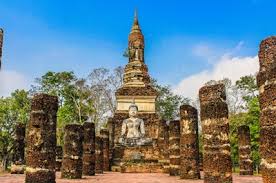Historical-Cultural Explanations for Thailand’s Identity
Thailand, formerly known as Siam, stands as a unique cultural and political entity in Southeast Asia. With a rich history shaped by its geography, religion, and monarchy, Thailand has developed a distinct national identity that sets it apart from its neighbors. The country’s ability to preserve its sovereignty amidst the colonial pressures of the 19th and 20th centuries, its deep-rooted traditions in Theravada Buddhism, and its enduring monarchy are key pillars of its national identity. This article explores the historical and cultural foundations that have shaped Thailand’s identity and how these elements continue to influence the nation’s modern-day ethos.
Geopolitical History: Sovereignty and Independence
One of the most significant aspects of Thailand’s national identity is its history of independence. Thailand is the only Southeast Asian country that was never colonized by a Western power, which plays a critical role in shaping its national pride and sense of sovereignty. This is a unique distinction in a region where many nations experienced long periods of colonial rule under European powers.
Diplomacy and Modernization
During the height of Western imperialism in the 19th century, Thailand (then Siam) found itself surrounded by European-controlled territories—British Burma to the west and French Indochina to the east. King Rama IV (Mongkut) and King Rama V (Chulalongkorn) were pivotal in steering Siam through these precarious times by engaging in diplomacy and strategic reforms.
King Mongkut and King Chulalongkorn, both educated in Western knowledge, pursued a policy of modernization that included legal, administrative, and military reforms, ensuring that Siam was seen as a progressive state capable of negotiating with Western powers. By modernizing infrastructure, education, and the military, these kings demonstrated Thailand’s capacity to manage its own affairs, thus preventing colonization. This historical experience cultivated a strong national identity based on the values of independence, adaptability, and diplomacy.
The Treaty of Friendship
Another key event that solidified Thailand’s independence and identity was the signing of the Bowring Treaty in 1855, which established trade relations with the British. Although the treaty opened Thailand to increased foreign influence and trade, it also enabled the country to maintain its autonomy. The ability of Thailand’s leadership to negotiate terms that would open the country economically while maintaining its political sovereignty is a hallmark of its national identity. This experience contrasts with the colonization experienced by neighboring countries and instills a sense of pride in Thailand’s ability to remain sovereign throughout history.
The Role of the Monarchy
The monarchy is another cornerstone of Thailand’s national identity. The Chakri Dynasty, founded in 1782, has played a central role in shaping the nation’s political, cultural, and social landscapes. The monarchy is not merely a political institution but also a spiritual and cultural symbol deeply embedded in Thai society.
Kings as Cultural Icons
In Thailand, the king is traditionally seen as a “Dhammaraja” — a ruler who governs according to the principles of Buddhism. This intertwining of religion and monarchy has led to the king being revered not just as a political leader but as a moral and spiritual figure. Kings like Rama V and Rama IX (Bhumibol Adulyadej) are venerated for their contributions to the country’s modernization and development. King Bhumibol, in particular, became a symbol of national unity and stability, reigning for 70 years and playing an active role in national development projects, particularly in rural areas.
The monarchy’s resilience, even during periods of political upheaval, has solidified it as a crucial element of Thai identity. The respect and reverence for the royal family are ingrained in everyday life, with images of the king prominently displayed in homes, businesses, and public spaces. The monarchy serves as a cultural touchstone that unites Thais across different regions, classes, and backgrounds.
Constitutional Monarchy and Modernity
In 1932, Thailand transitioned from an absolute monarchy to a constitutional monarchy, a shift that was not without its challenges. However, this change allowed Thailand to modernize its political system while still preserving the cultural and symbolic significance of the monarchy. Today, the monarchy continues to play an influential role in Thailand’s identity, even as the country grapples with political polarization and pro-democracy movements.
Theravada Buddhism: A Spiritual Foundation
Religion is another critical component of Thailand’s national identity, with approximately 95% of the population adhering to Theravada Buddhism. The teachings of Buddhism are deeply woven into the fabric of Thai society, influencing everything from education and law to art and architecture.
Buddhism and Everyday Life
Buddhism in Thailand is not just a matter of personal faith but a social institution that permeates daily life. Monks are highly respected figures, and many young men are expected to spend time in a monastery as part of their cultural and spiritual development. Festivals like Visakha Bucha Day, which commemorates the birth, enlightenment, and death of the Buddha, are national holidays celebrated with fervor across the country.
Temples (known as wat) are central to Thai communities, serving not only as places of worship but also as centers for education and community gatherings. The architectural beauty of temples, such as Wat Pho in Bangkok and Wat Phra That Doi Suthep in Chiang Mai, showcases the deep connection between Buddhism and Thai culture. These temples, with their golden spires and intricate carvings, symbolize Thailand’s devotion to its religious and cultural heritage.
The Role of Buddhism in Social Values
Buddhist teachings also shape many of the social values prevalent in Thai society, such as compassion (metta), non-violence, respect for hierarchy, and mindfulness. These values are reflected in the way Thai people interact with one another, as well as in their approach to governance and law. For instance, the concept of karma—the idea that actions have moral consequences—is a fundamental belief that influences how people think about justice and morality.
The connection between Buddhism and the monarchy further reinforces the religion’s role in shaping national identity. Kings are seen as protectors of the Buddhist faith, and royal patronage of temples and religious events remains an important aspect of the monarchy’s public role.
Thai Language and National Unity
Language is a powerful tool for fostering national identity, and in Thailand, the Thai language serves as a unifying force. Standard Thai, or Central Thai, is the official language of the country, used in government, media, and education. It is a source of national pride and a key element in preserving Thai culture.
Linguistic Diversity and Cultural Preservation
While Central Thai is the official language, Thailand is home to a rich linguistic diversity, with regional languages such as Isan, Northern Thai, and Southern Thai widely spoken. The government promotes the teaching of Standard Thai to ensure national unity, but local languages are still used in daily life and are integral to regional identities.
The Thai script, derived from Old Khmer, is a cultural treasure in itself, and the preservation of the Thai language is seen as essential to maintaining Thailand’s cultural heritage. The importance placed on the Thai language is evident in national policies, which prioritize its teaching in schools and its use in all official capacities.
Festivals and Cultural Traditions
Thailand’s national identity is also shaped by its rich tradition of festivals, rituals, and cultural practices. Many of these celebrations are tied to Buddhism, while others reflect Thailand’s agricultural roots and its reverence for nature.
Songkran: The Thai New Year
One of the most famous Thai festivals is Songkran, the traditional Thai New Year, celebrated in April. It is marked by water fights, where people splash water on each other as a symbol of cleansing and renewal. While Songkran is a joyful and playful holiday, it also has deep cultural significance, with traditional activities including visiting temples, offering food to monks, and paying respects to elders.
Loy Krathong: A Celebration of Water
Another beloved festival is Loy Krathong, which takes place in November. During this festival, people release floating lanterns or krathongs (small boats made of banana leaves) onto rivers to honor the water goddess and seek forgiveness for polluting the waterways. The festival highlights Thailand’s close connection to nature and the importance of water in both agriculture and daily life.
The Art of Thai Cuisine
Thai cuisine, with its bold flavors and intricate preparation techniques, is another key aspect of Thailand’s cultural identity. Dishes such as pad thai, som tum (papaya salad), and tom yum goong (spicy shrimp soup) are not just meals but cultural symbols that reflect the country’s agricultural heritage, resourcefulness, and communal way of life. Food plays a central role in Thai festivals and social gatherings, further cementing its place in the nation’s identity.
Conclusion: Thailand’s Unique Identity
Thailand’s national identity is a tapestry woven from its unique historical experiences, cultural traditions, and spiritual beliefs. The country’s ability to maintain its sovereignty during the colonial era, its deep-rooted monarchy, and its commitment to Theravada Buddhism have all contributed to a strong sense of national pride and unity. While Thailand continues to modernize and adapt to global influences, these historical and cultural elements remain central to the nation’s identity.
In an increasingly interconnected world, Thailand’s identity continues to evolve, but its foundations in independence, spirituality, and cultural preservation remain as important as ever. These elements not only define what it means to be Thai but also provide a sense of continuity and stability in an ever-changing global landscape.


